'It had been a ferocious fight'
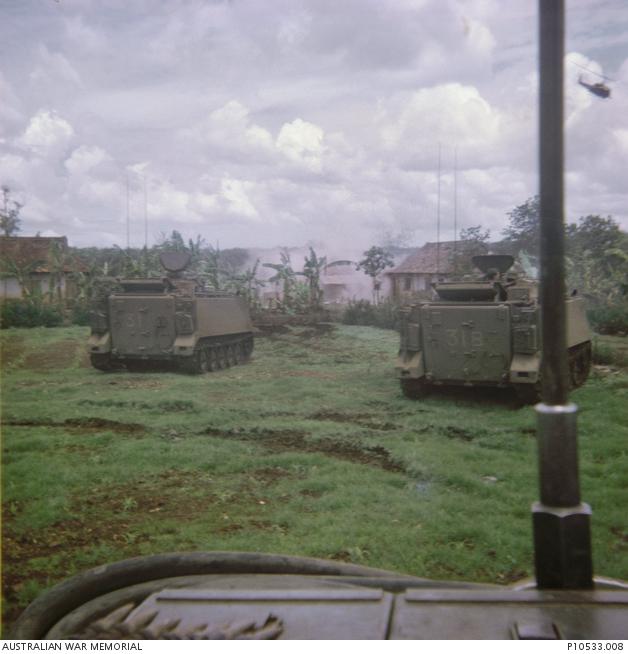
Binh Ba on the first day of the battle. The 5th Battalion, The Royal Australian Regiment (5RAR) began a search-and-clear of the village of Binh Ba, following an attack on a Centurion tank. The operation evolved into an extensive search of the village with tanks and infantry.
Second Lieutenant Brian Sullivan was lucky. With his head and upper body exposed above the cupola of his tank, he was directing the movement of his troop, and talking to an armoured personnel carrier commander, when a rocket-propelled grenade (RPG) was fired point blank at them both.
When Sullivan saw the smoke trail of the missile coming directly towards him, he called out “Duck!” and threw himself forward just as it flew between them, cutting his shirt and grazing his shoulder with its tail fin.
Sullivan had narrowly escaped death in what was one of the more significant actions fought by Australian soldiers during the Vietnam War – the battle of Binh Ba – which took place 50 years ago today.
Before the battle, soldiers of the 1st Australian Task Force had fought mainly in open country or jungle settings, but this battle took place in the village of Binh Ba, less than ten kilometres from the Australian base in Phuoc Tuy Province, South Vietnam, against a large, well-armed communist force.
Former head of military history at the Australian War Memorial, Ashley Ekins, researched and wrote two volumes of the Australian official history of the Vietnam War: On the offensive and Fighting to the finish.
“It was a furious battle,” Ekins said. “From the moment the Australians entered Binh Ba with their Ready Reaction Force of infantry, armoured personnel carriers [APCs], and tanks, they were prepared for a battle, and the enemy brought on a battle …”
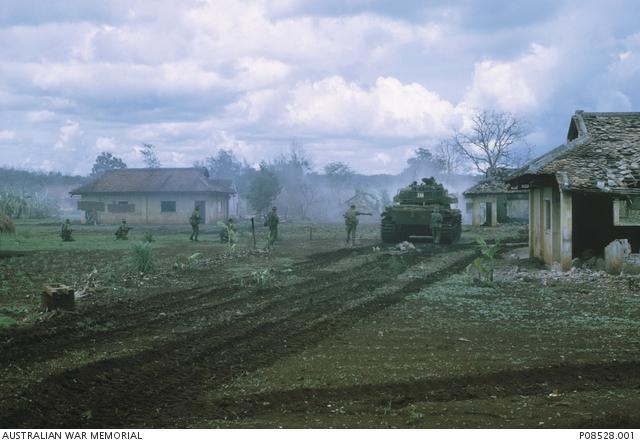
The first in a series of three images showing a Centurion MkV/1 tank (number 244) from B Squadron 1 Armoured Regiment and infantry from the 5th Battalion, The Royal Australian Regiment (5RAR) advancing through the village of Binh Ba while under enemy fire.
In early June 1969, the newly arrived 6th Battalion of the Royal Australian Regiment deployed north of the Australian Task Force base at Nui Dat, on Operation Lavarack. The men immediately began encountering large groups of North Vietnamese Army (NVA) and Viet Cong (VC) soldiers on the move.
Then, on the evening of 5 June 1969, a combined communist force of well-armed and resolute soldiers occupied the village of Binh Ba.
“Whether the enemy were invited in or they just came, we’ll never know for sure,” Ekins said.
“It was an idyllic little place … a beautifully set out village of whitewashed houses with terracotta roof tiles … surrounded by a large rubber plantation, but it had been under communist control for most of the three years that the task force had been there … So it looked peaceful, but in actual fact the local people harboured sympathies with the communist insurgents.
“The Australians had gone in there on many occasions trying to bring aid … and the troops had even played soccer with the locals back in the early days … but not anymore. “
At 8 am on the morning of 6 June 1969, an Australian Centurion tank and armoured recovery vehicle were moving north past the village when they were fired on; an RPG damaging the tank and severely wounding at least one of the crew.
“They fired upon the tank going past just to bring it on, and they didn’t flee like the enemy normally did,” Ekins said. “They usually chose and prepared their battlegrounds well, and made sure they had the advantage. Then when the fighting began, the minute they lost that advantage, they would withdraw as quickly as they could. It was a case of ‘hit and run’, basically, but that wasn’t what went on at Binh Ba.”
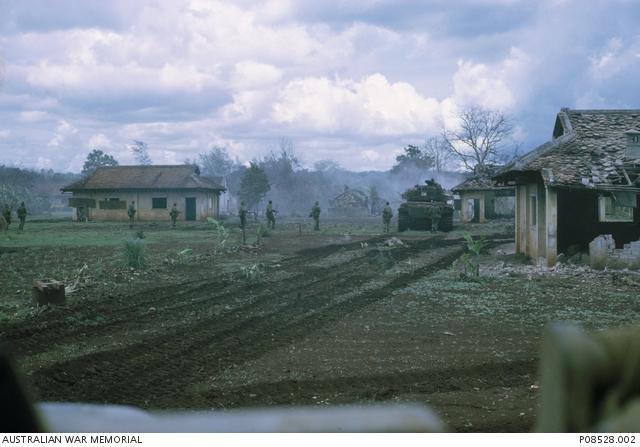
The second in a series of three images showing a Centurion MkV/1 tank (number 244) from B Squadron 1 Armoured Regiment and infantry from the 5th Battalion, The Royal Australian Regiment (5RAR) advancing through the village of Binh Ba while under enemy fire.
The district chief contacted his superiors for assistance, and a small South Vietnamese force was sent in. When they were stopped by heavy fire, they requested Australian support.
Two and a half hours later, the Australian task force launched Operation Hammer, sending an understrength infantry company of 5RAR into the village, supported by armoured vehicles and artillery.
“They waited a long time while the district chief and others tried to get all the civilians out,” Ekins said.
“The villagers were ordered to leave and hundreds came out, most of the 1,300 people who lived there, but we know that there were still some left from what happened later.
“The Australians then assaulted from the east, westwards down through these streets, with tanks and APCs, and it became intense the minute they got in there.
“They’re under very heavy fire, and during the course of that first assault, all four tanks are hit. One of them is badly disabled, and it’s abandoned basically, and there’s much furious fighting.
“The Australians had no idea what they were going into; they thought two platoons of enemy had come into the village, but they didn’t know then that they were North Vietnamese Army regulars and that it was the best part of a battalion, and they were there for a fight.
“The enemy they were facing had evolved by now into a much more complex force … a much more sophisticated enemy, very well-equipped with modern weapons: AK-47 assault rifles, mortars, recoilless rifles, and their most powerful rocket-propelled grenades, the RPG 7.”
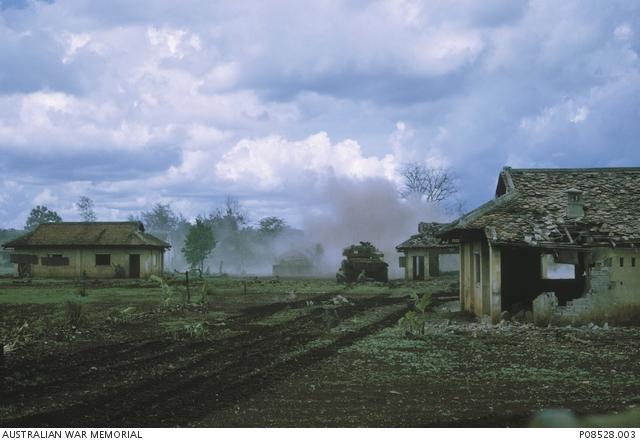
The third in a series of three images showing a Centurion MkV/1 tank (number 244) from B Squadron 1 Armoured Regiment and infantry from the 5th Battalion, The Royal Australian Regiment (5RAR) advancing through the village of Binh Ba while under enemy fire.
What followed was two days of fierce house-to-house fighting as the Australians attempted to remove the NVA and VC from the village, a battle unlike any other experienced by Australian troops in Vietnam.
“By now the Australians were aware they had encountered a formidable enemy force that was prepared to stand and fight,” Ekins said.
“It was clearly much more than the two platoons they thought were there; this was several companies of a regular main force regiment, and they were hardened fighters. They were experienced – well-trained, well disciplined, and well-armed – and they had cunning and daring and effective tactics against the armour. It was never touch-and-go, but it could have been.
“It was tactically advantageous for the enemy to get the Australians into a built-up environment where the tanks were more vulnerable … The enemy could get in close because of the streets and the houses. They could actually wait for the tanks to come in up close to them, and then fire their RPGs and duck back into the houses and hide in the tunnels and bunkers underneath.”
It was during this fighting that Private Wayne Teeling was killed by enemy fire.
“He was a National Serviceman,” Ekins said. “He was called up and he went up to do his duty and he was the only Australian soldier killed. He’d just joined the unit earlier in the day and this was his first experience of battle.”
He left behind a pregnant wife, and never got to see his son, who was named Wayne in memory of his father.
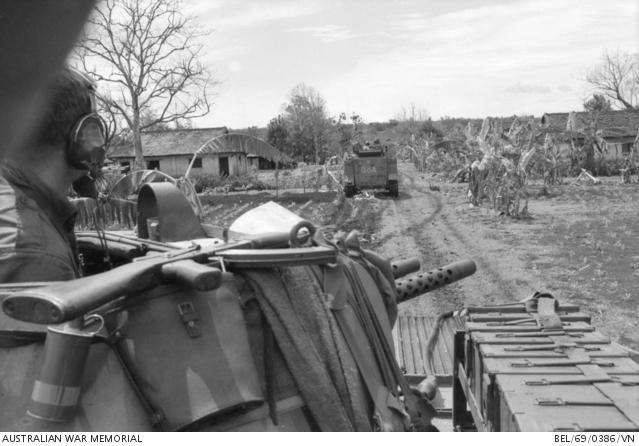
Commander of an Armoured Personnel Carrier (APC) of B Squadron, 3rd Cavalry Regiment, keeps a sharp look out into a banana plantation on the roadside near Binh Ba.
“The operations officer said that the fighting ebbed and flowed, becoming so fierce and confused … that it defied detailed description,” Ekins said.
“Not all of the civilians had got out, for one reason or another … and a number of Australian soldiers performed very brave acts, risking their own lives to lead some of these people to safety.
“The tanks were an absolute godsend and we shouldn’t underestimate that. One of the commanders later said: ‘We should never leave home without them.’ The tanks really were the saving factor in this battle, and infantry lives lost were very small because of the contribution of the tanks and the APCs and their concentrated firepower from heavy machine-guns.”
When members of the 1st Australian Civil Affairs Unit entered Binh Ba on the morning of 8 June, they found a scene of utter devastation.
“They found that about one in five of the houses were completely destroyed and about half the houses were damaged,” Ekins said. “The task force hadn’t destroyed it, and hadn’t saved it, but had severely damaged it.”
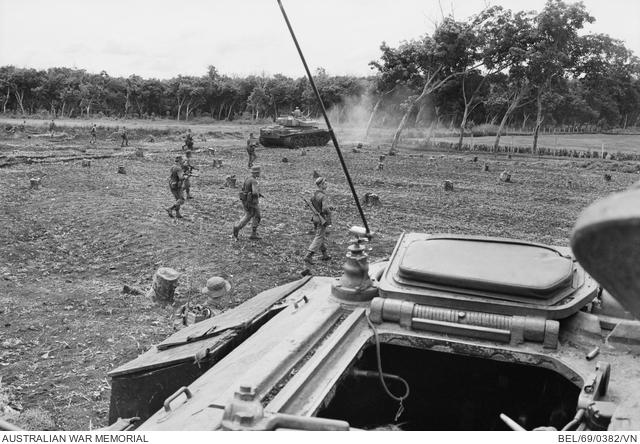
During Operation Hammer, troops of 6 Platoon, B Company, 5th Battalion, The Royal Australian Regiment (5RAR), commanded by Major Murray Blake, supported by Centurion tanks of No 4 Troop, B Squadron, 1st Armoured Regiment (1AR) RAAC, sweep towards the edge of a rubber plantation at Duc Trung, five miles north of the 1st Australian task force (1ATF) base at Nui Dat. The Australians inflicted heavy casualties on a strong force of North Vietnamese army (NVA) soldiers.
The Civil Affairs Unit organised the distribution of food, water, and aid to villagers, and went on to oversee repair and reconstruction work in the village.
“The task force took on the job of repairing it all,” Ekins said. “But there was no way their actions were ever going to win the allegiance of the people …
“It never really became an Australian-friendly village, but this was the nature of the war, and trying to win hearts and minds when you have fought a battle like that is a pretty hard call.
“This was seen as a great victory for the taskforce … but it had been a ferocious fight.”
The Australians returned to Nui Dat with one dead and ten wounded. The Vietnamese casualties were estimated at more than 100 killed and six wounded.
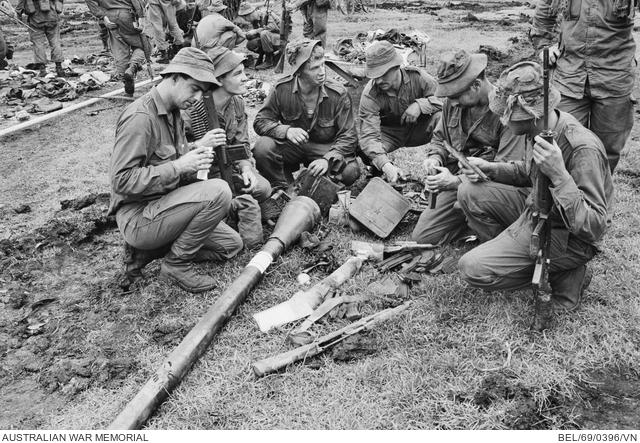
Soldiers of B Company and the Intelligence Section of 5 Battalion, The Royal Australian Regiment (5RAR), inspecting captured enemy weapons at Binh Ba after the battle.
“We still don’t know with certainty, even today, what the enemy were really trying to achieve,” Ekins said.
“They claim they were trying to disrupt the pacification program, but why they brought on a battle so close to the task force, involving armour, remains unclear, even today.
“It’s always claimed that we drove the 33rd North Vietnamese Army out of the province. This was the first time they came in strength, and they were routed, but they would be back. They had sustained pretty heavy losses, and they had tested the Australians and found that they were a formidable force … but the war was far from over.
“This was a victory, but at the same time public opinion was turning, and it was turning not because of the protests in the streets, not because of any anti-war media coverage, rhetoric, or parliamentary debate. It was turning, I believe, solely because the casualties were mounting and, despite claims of progress, no one could show the war was any closer to an end.”